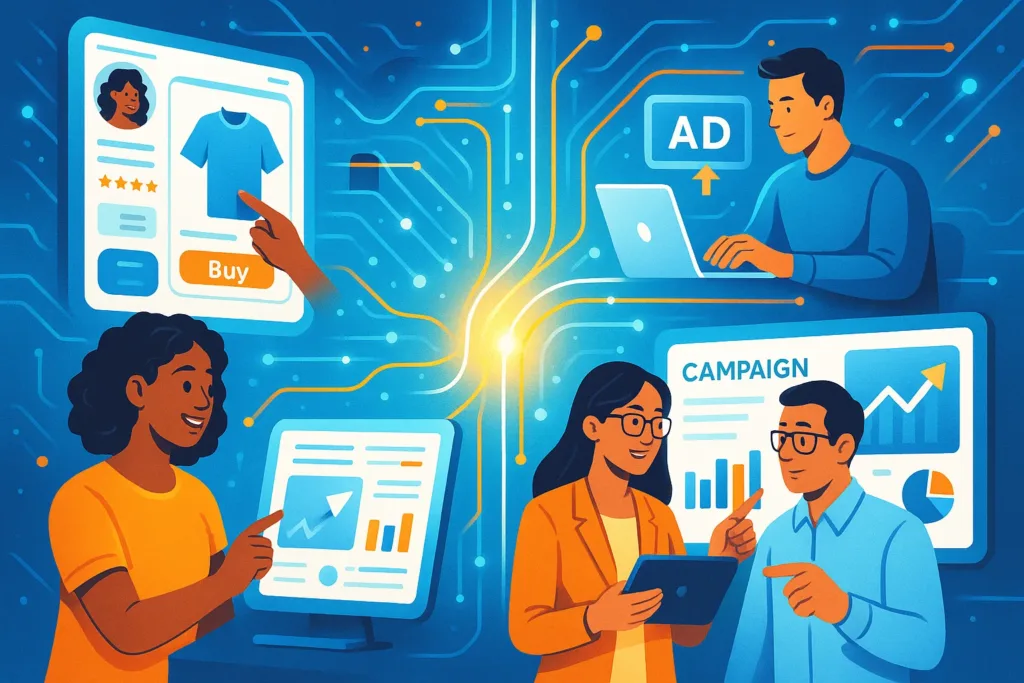To build an AI marketing strategy that delivers real results, businesses need more than just access to the latest tools—they need to rethink how marketing campaigns are designed, executed, and scaled. AI and machine learning now shape everything from personalized marketing content to real-time campaign adjustments.
This guide will help you create an AI marketing strategy tailored to your business goals, using proven insights, real-world examples, and practical steps to strengthen your marketing efforts in a data-driven landscape.
What is AI Marketing Strategy?
AI marketing strategy is a structured approach that uses AI-powered tools and machine learning to enhance decision-making, optimize workflows, and deliver highly personalized customer experiences. Rather than replacing human input, AI helps amplify it—enabling marketing teams to work smarter, test faster, and scale more efficiently.
When integrated correctly, AI can make marketing processes more responsive and customer-centric. Businesses leveraging AI for customer acquisition have seen customer acquisition costs reduce by up to 50% in some industries..These outcomes reflect the impact of strategic AI use—not just adopting technology, but aligning it with business and marketing goals.
A well-structured AI strategy weaves together analytics, automation, and targeted outreach to drive best results across channels.
Role of Generative AI
Generative AI tools are becoming essential in modern marketing efforts. Platforms like ChatGPT, Jasper, and Midjourney help streamline creative development by generating concepts, drafting social media posts, writing email marketing content, and adjusting messaging to suit various audiences.
These tools use behavioral and intent signals to produce personalized, context-aware content at scale. According to a 2024 Deloitte study, one B2C company saw a 17% uplift in click-through rates after using generative AI to tailor product descriptions. By integrating AI-powered tools into content production, marketers can test more variants, cut turnaround time, and meet personalization demands more efficiently.
Foundational Components
Every AI marketing strategy is built on four core pillars: automation, insights, personalization, and data integrity.
- Automation: AI helps automate key marketing processes such as ad bidding, lead prioritization, and content scheduling. Tools like HubSpot and Salesforce embed AI into daily operations, freeing up resources and allowing marketers to focus on strategic execution.
- Insights: Predictive analytics and data modeling empower marketers to use these insights for forecasting trends, refining targeting, and improving segmentation. AI helps decode customer signals faster than manual analysis, guiding smarter decisions across campaigns.
- Personalization: AI-powered marketing thrives on the ability to tailor messages at scale. From personalized product suggestions to dynamic email content, AI enables marketers to serve the right message at the right moment in each customer’s journey.
- Data Quality: Clean, structured, and privacy-compliant data is critical to success. AI can only be as effective as the data it works with. Poor-quality data introduces risk, while accurate datasets enhance targeting precision and model reliability.
Aligning these elements with your overall marketing goals is key. AI can make your marketing more agile and relevant, but it requires ongoing calibration and human oversight to ensure continued effectiveness. A clear, intentional AI strategy transforms good campaigns into scalable, optimized systems that adapt and improve over time.
Implement AI Marketing Strategy: Step-by-Step Guide
Building a successful AI marketing strategy requires structure, alignment, and adaptability. This step-by-step guide outlines the critical stages to ensure a thoughtful and scalable approach that enhances marketing efficiency and drives measurable outcomes.

- Assess current marketing operations and data infrastructure for AI readiness.
- Define clear strategic objectives tied to business outcomes.
- Select AI tools and platforms based on functionality and scalability.
- Implement AI solutions in phases to manage complexity and gather feedback.
- Monitor performance metrics and refine your AI models continuously.
Assess Current Operations
Start by auditing existing workflows, CRM systems, and campaign performance to determine where AI can add value. Focus on identifying inefficiencies, data silos, or manual tasks that could be automated. Also assess data quality—AI marketing strategy implementation depends heavily on accessible, clean, and ethically collected data. Businesses with structured first-party data and consistent performance metrics are better positioned to activate AI effectively.
Define Strategic Objectives
Determine what the AI marketing strategy aims to achieve. Objectives may include increasing conversion rates, reducing churn, enhancing personalization, or improving ROI from paid media. Tie each objective to a quantifiable KPI. For example, “use AI-driven lead scoring to improve sales-qualified leads by 15% over six months.” This ensures that use cases are aligned with broader business goals and remain measurable over time.
Select Appropriate Marketing Automation Tools
Tool selection should be driven by specific needs and operational compatibility. Evaluate platforms like Adobe Sensei, Salesforce Einstein, or Meta Advantage+ based on whether they support automation, personalization, predictive analytics, or content generation. Consider integration flexibility, data privacy compliance, and learning curve. Choosing the right tech stack is a foundational decision that shapes the future performance of your AI marketing strategy.
Roll Out in Stages
Begin with pilot programs targeting high-impact areas such as ad targeting or email optimization. Gradually expand AI integration as teams gain confidence and data confirms value. This phased approach reduces operational risk and ensures that learnings are applied iteratively. Early-stage pilots may highlight unexpected friction points, making staged implementation a practical strategy for sustainable adoption.
Monitor and Refine Continuously
An effective AI marketing strategy is never static. Continuously monitor performance data—click-through rates, engagement metrics, customer lifetime value—and feed those insights back into your models. Retraining algorithms based on updated data helps avoid model drift and ensures relevance. Leading companies use AI to monitor not just marketing outcomes but the accuracy and fairness of AI-driven decisions themselves.
Why AI Marketing Strategy Matters
AI is redefining how businesses compete, connect, and communicate. An effective AI marketing strategy positions brands to adapt quickly, personalize efficiently, and scale intelligently.

As marketing becomes increasingly data-intensive, artificial intelligence bridges the gap between insight and action, making strategy not only faster but smarter.
Data-Driven Evolution in Marketing
Access to large-scale customer data has transformed marketing from intuition-based to evidence-based. AI enables real-time analysis of structured and unstructured data, turning customer signals into actionable insights. IBM has published several reports highlighting the growing adoption of AI and data analytics in business operations. For instance, the “IBM Global AI Adoption Index 2023” discusses the increasing integration of AI in various business functions, including marketing.
Efficiency Through Automation
Automation is central to AI marketing strategy execution. From programmatic advertising to lead scoring, AI automates repetitive tasks, freeing teams to focus on high-value work. For example, marketing automation powered by AI can reduce campaign launch time by up to 50%, according to Adobe. Consistency, speed, and accuracy increase when workflows are algorithmically managed.
Personalized Experiences with The Power Of AI
AI allows marketers to tailor interactions at scale. Recommendation engines, dynamic content blocks, and personalized email flows are now driven by behavioral models that adapt in real time. A Salesforce study found that 73% of consumers expect brands to understand their needs—something AI enables by continuously learning from individual user behavior across channels.
Predictive and Real-Time Optimization
AI doesn’t just react—it forecasts. Predictive analytics helps marketers anticipate customer behavior, while real-time optimization adjusts bidding, creative, or targeting on the fly. This dual capability strengthens campaign agility. Tools like Google’s Performance Max use machine learning to optimize ad delivery dynamically based on live performance data.
Gaining Strategic Advantage
Brands integrating AI into their marketing strategies often gain a distinct advantage in crowded markets. AI-powered approaches support faster campaign rollouts, deeper audience understanding, and more precise targeting. As competition intensifies, the ability to adapt quickly and deliver contextually relevant experiences becomes a key differentiator—one that AI enables through real-time data processing and continuous optimization.
How to Implement AI in Marketing
AI is not a single solution—it enhances every layer of the marketing funnel. From creative production to campaign analysis, AI-driven tools and systems streamline delivery, increase relevance, and improve ROI.

A successful AI marketing strategy identifies where automation, analytics, and learning models can provide consistent performance gains.
Content Creation With AI Tools
Generative AI tools produce on-brand assets—copy, video, imagery—at scale. Marketers use solutions like Jasper for blog drafts, Synthesia for AI video avatars, or Canva’s AI assistant for visual content. These tools enhance creative workflows while ensuring that brand voice and tone remain consistent. Teams leveraging generative AI often experience increased content production speed while maintaining quality standards. These tools support faster drafting, editing, and iteration—enabling marketers to meet growing content demands without compromising consistency or brand voice.
Scalable Personalization Tactics
AI enables hyper-personalization through micro-segmentation, behavioral analysis, and dynamic content delivery. Platforms like Dynamic Yield or Insider adjust website and email experiences in real time based on user data. This level of personalization boosts engagement, with studies showing a 15–25% lift in conversion rates when AI-driven content adapts to individual preferences.
Process Optimization
Campaign setup, testing, and management benefit from AI-based streamlining. Smart scheduling tools, automated A/B testing, and real-time performance alerts reduce operational complexity. Tools like Optimizely and Adobe Marketo Engage use AI to recommend test variants, identify underperforming segments, and fine-tune timing for outreach. This optimization shortens cycles from planning to execution.
Data-Led Decision Automation
AI transforms marketing analytics from insight reporting to real-time decision-making. Systems interpret performance metrics and customer behavior to trigger next-best actions—such as retargeting, offer adjustments, or budget reallocation. Platforms like Salesforce Marketing Cloud and Oracle Eloqua provide AI-driven recommendations that adjust campaign direction based on live inputs, turning data into immediate outcomes.
Benefits Of Implementing An Ai Marketing Strategy
An AI marketing strategy delivers measurable gains across efficiency, creativity, targeting precision, and customer experience. By embedding intelligence into every layer of execution, marketers drive consistent results and create meaningful brand interactions at scale.

Personalization at Scale
AI enables one-to-one marketing on a one-to-many scale. Using machine learning models, brands can deliver personalized content, product recommendations, and messaging based on individual behaviors and preferences. Netflix, for example, attributes over 80% of viewer activity to its AI-driven recommendation engine—demonstrating scalable personalization’s power in customer engagement.
Improved Campaign Results
Through continuous testing, AI identifies top-performing variables—headlines, visuals, CTAs—and automatically reallocates budget toward winning combinations. Dynamic targeting and performance-based bidding systems result in higher click-through rates and conversion efficiency. Meta’s Advantage+ Shopping Campaigns have demonstrated significant improvements in advertising performance. Specifically, a meta-analysis of 31 tests revealed that integrating Advantage+ Shopping Campaigns into existing strategies led to a 32% increase in Return on Ad Spend (ROAS) compared to traditional manual ad sets.
Faster Execution
AI compresses campaign cycles by automating tasks such as audience building, content generation, and ad placement. What once required days of manual setup now occurs in real time. Tools like Smartly.io or Adobe Sensei reduce time-to-launch by auto-populating assets, syncing platforms, and managing bids autonomously.
Enhanced Team Productivity
Routine tasks—from scheduling to reporting—are delegated to AI, enabling marketers to refocus on strategy, creativity, and innovation. A Forrester study found that marketing teams using AI save up to 20 hours per week on execution-related tasks, redirecting effort toward high-impact planning and cross-channel optimization.
Stronger Brand Connections
Hyper-relevant communication fosters trust and loyalty. AI refines messaging based on sentiment analysis, interaction history, and contextual signals, ensuring relevance at every touchpoint. Brands that use AI to personalize emails see up to 6x higher transaction rates, according to Experian—proof that relevance drives long-term brand affinity.
Smarter Customer Targeting With AI Marketing Tools
AI segments audiences using real-time behavioral, transactional, and contextual data. Instead of broad demographic groups, marketers can now target based on predicted interests, purchase intent, and lifecycle stage. Predictive targeting engines, like those in Salesforce and Oracle CX, increase campaign precision and reduce wasted spend.
Creative Support and Efficiency
AI tools assist in brainstorming, scripting, designing, and iterating creative assets. They identify which formats, tones, or themes resonate with audiences by analyzing engagement patterns. Canva’s Magic Write or ChatGPT-based ideation tools accelerate concept development while keeping creative aligned with brand guidelines.
Revenue Growth Opportunities
AI enhances customer lifetime value by refining upsell opportunities, minimizing churn, and delivering more accurate product recommendations. Personalized experiences driven by intelligent systems help improve revenue and boost marketing ROI. These outcomes stem from AI’s ability to deliver with precision and continuously adapt based on evolving customer behavior.
Real-World Best AI Marketing Strategy Use Cases
AI marketing strategy isn’t conceptual—it’s actively shaping how brands compete, connect, and convert.

From automation and personalization to dynamic campaign optimization, businesses across industries are achieving measurable performance improvements using AI.
Customer Engagement Wins
Domino’s Pizza implemented an AI-powered voice and chatbot system called Dom to simplify ordering and enhance the customer experience. This virtual assistant reduced response times and supported seamless multi-platform interactions. Within the first year of launch, Domino’s reported a 20% increase in repeat orders attributed to Dom’s impact on convenience and engagement.
📌 Domino’s AI-Powered Ordering: Medium
Personalized Campaign Success
Sephora leverages AI to drive personalization across its mobile app and email campaigns. Using customer behavior data, the brand customizes product recommendations and promotional content, enhancing relevance and engagement. These efforts led to a reported uplift in both click-through rates and conversion performance.
📌Sephora: Personalization with AI – Harvard Business Review
Enhanced Performance via AI Platforms
L’Oréal integrated Adobe Sensei into its digital ad infrastructure to optimize creative versions and audience segmentation in real time. As a result, the company saw significant improvements in ad engagement and cost efficiency. Real-time optimization helped adapt messaging dynamically to maximize performance across multiple regions.
📌 L’Oréal & Adobe Sensei – Case Study by Adobe
Common Challenges in AI Marketing Strategy Design
While an AI marketing strategy offers measurable value, its implementation is not without obstacles. Misaligned expectations, unchecked automation, and poor data governance can hinder success.

Recognizing these risks early allows businesses to integrate AI responsibly and sustainably across their marketing operations.
Robotic Tone in AI Output
AI-generated content can sometimes sound mechanical or generic, risking disconnection from the brand’s personality. Maintaining a consistent voice requires combining AI capabilities with editorial oversight.
Brands should build tone-of-voice guidelines directly into AI prompt structures or model fine-tuning processes. For example, Grammarly Business and Jasper allow users to define voice parameters, helping AI stay on-brand and conversational.
Example:
A lifestyle brand known for its playful, conversational tone uses Jasper to generate product descriptions for a new clothing line. Initially, the AI produces content that feels overly formal and generic—phrases like “This item is suitable for various occasions” don’t match the brand’s energetic voice.
To fix this, the content team sets specific tone instructions in the prompt: “Write in a friendly, upbeat style similar to our Instagram posts. Use contractions, rhetorical questions, and a sense of humor.” With these guidelines, Jasper starts generating copy like: “Ready to turn heads? This tee’s your new go-to for everything from coffee runs to couch marathons.”
This adjustment keeps the AI on-brand while still benefiting from automated speed and scale.
Excessive Automation Dependence
Relying too heavily on automation can lead to blind spots, such as missing contextual cues or failing to respond to unexpected changes in consumer behavior. A balanced AI marketing strategy retains human oversight for creative judgment, escalation points, and strategic pivots. AI should support decisions, not replace them—especially in high-stakes environments like crisis communication or brand repositioning.
Bias in Algorithms
AI systems trained on biased or incomplete data can reinforce stereotypes or exclude segments unfairly. To mitigate this, marketers must conduct regular audits of training data, apply fairness constraints, and use tools that detect algorithmic bias. Frameworks like Google’s PAIR (People + AI Research) provide guidance on responsible AI design and inclusive modeling practices.
Lack of Clear Direction
Without a defined roadmap, AI efforts often become fragmented or underutilized. Success depends on having a documented strategy, governance framework, and success metrics. Assigning ownership, outlining ethical boundaries, and setting benchmarks for performance ensure that AI marketing initiatives are aligned with long-term business goals—not just short-term experimentation.
If you’re considering launching your own AI-driven marketing agency, our comprehensive guide, Starting an AI Agency, offers a step-by-step roadmap. It covers everything from defining your niche and building a tech stack to scaling operations and staying competitive in the evolving AI landscape. This resource is designed to help you navigate the complexities of establishing a successful AI marketing agency.
AI Marketing Tools Mentioned in the Guide
| Tool Name | Category | Primary Use Case |
| ChatGPT | Generative AI | Content ideation and generation |
| Jasper | Generative AI | Marketing copy creation |
| Midjourney | Generative AI | Visual content generation |
| Salesforce | CRM / Automation | Lead scoring, campaign optimization |
| HubSpot | CRM / Automation | AI-assisted marketing processes |
| Google AI Analytics | Analytics | Predictive insights and campaign forecasting |
| Dynamic Yield | Personalization | Real-time content personalization |
| Insider | Personalization | Behavioral targeting and personalization |
| Optimizely | Optimization | A/B testing and experience optimization |
| Adobe Marketo Engage | Automation | Campaign orchestration and targeting |
| Canva Magic Write | Creative AI | Design and text generation |
| Synthesia | Generative AI Video | AI-based video content |
| Meta Advantage+ | Ad Optimization | Automated ad targeting and bidding |
| Adobe Sensei | AI Optimization | Real-time creative and audience optimization |

